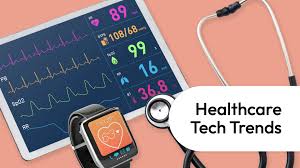How Wearable Technology Is Transforming Healthcare in 2025
In recent years, wearable technology has evolved far beyond fitness trackers and step counters. From smartwatches that monitor heart rate to biosensors detecting chronic diseases, this innovative tech is revolutionizing the healthcare industry. In 2025, wearable devices are not just enhancing personal wellness—they are reshaping how care is delivered, monitored, and managed.
What Is Wearable Technology?
Wearable technology refers to electronic devices worn on the body that collect, analyze, and transmit health-related data. These devices use sensors, wireless connectivity, and AI algorithms to monitor various health metrics in real-time.
Common examples include:
- Smartwatches (e.g., Apple Watch, Samsung Galaxy Watch)
- Fitness trackers (e.g., Fitbit, Garmin)
- Smart rings (e.g., Oura Ring)
- Wearable ECG monitors
- Continuous glucose monitors (CGMs)
1. Real-Time Health Monitoring
One of the biggest benefits of wearable tech is continuous, real-time monitoring of vital signs. This is especially useful for:
- Heart rate & arrhythmia detection
- Blood oxygen levels (SpO2)
- Sleep cycles and quality
- Respiratory rates
For example, the Apple Watch Series 9 can detect irregular heart rhythms and notify users about potential atrial fibrillation, helping catch heart conditions early.
2. Managing Chronic Conditions
Wearables are game-changers for people managing chronic conditions like:
- Diabetes: Devices like the Dexcom G7 CGM provide real-time glucose monitoring without finger pricks.
- Hypertension: Blood pressure monitoring wearables allow patients to track trends and share data with their doctors.
- Asthma & COPD: Smart inhalers track usage and symptoms to ensure better medication adherence.
3. Early Disease Detection
With advancements in biosensing technology, some wearables can detect early signs of illness—even before symptoms appear.
For instance, researchers at Stanford University found that smartwatches can detect COVID-19 infections up to 9 days before symptoms through heart rate and temperature patterns.
4. Enhancing Remote Patient Monitoring (RPM)
Remote patient monitoring is essential for telemedicine and home-based care. Wearables send real-time data to healthcare providers, enabling:
- Fewer hospital visits
- Early intervention
- Post-surgery recovery tracking
- Improved elderly care
Hospitals like the Mayo Clinic are actively using wearable RPM to reduce readmission rates and improve outcomes. Source
5. Personalized Preventive Care
With enough user data, wearables can predict and prevent health issues. Using AI, these devices offer:
- Customized fitness recommendations
- Alerts about unhealthy trends
- Early mental health intervention through mood or sleep analysis
Platforms like WHOOP offer insights tailored to recovery, strain, and sleep cycles—helping users optimize their wellness routines.
6. Empowering Patients
Patients now have direct access to their own health data. This leads to:
- Better health literacy
- More informed decisions
- Improved communication with healthcare professionals
When users understand their vitals and trends, they’re more likely to take proactive control of their health.
Challenges & Considerations
Despite the benefits, wearable healthcare technology faces several challenges:
- Data privacy and security
- Device accuracy and reliability
- Regulatory and compliance issues
- Tech fatigue and user adherence
Healthcare providers and tech companies must collaborate to ensure ethical and effective use.
The Future of Wearables in Healthcare
As AI, IoT, and biosensing improve, wearable devices are expected to:
- Integrate with electronic health records (EHRs)
- Predict medical emergencies using machine learning
- Monitor mental health through neurotech wearables
- Provide real-time insights to doctors and caregivers
The market is projected to reach $195 billion by 2027, proving just how critical this tech has become. Statista Report
Conclusion
Wearable technology is not just a trend—it’s a transformative tool redefining modern healthcare. From chronic disease management to predictive analytics and real-time monitoring, it empowers patients and providers alike.
